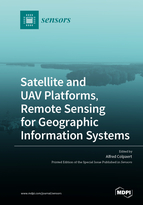Satellite and UAV Platforms, Remote Sensing for Geographic Information Systems
A special issue of Sensors (ISSN 1424-8220). This special issue belongs to the section "Remote Sensors".
Deadline for manuscript submissions: closed (22 April 2022) | Viewed by 28807
Special Issue Editor
Interests: physical geography; geology; geoinformatics; UAVs
Special Issues, Collections and Topics in MDPI journals
Special Issue Information
Dear Colleagues,
Satellite and UAV (Unmanned Aerial Vehicle) imagery has become an important source of data for Geographic Information Systems (GISs). Remote Sensing and GISs are part of the broader concept of Geoinformatics. Satellite imagery in a wide range of spatial, spectral, and temporal resolutions provides the scientific community with rapidly available global data to be used as an integral part of spatial data structures and analyses. Remote sensing platforms, such as Modis and Landsat, have a unique historical record of providing tens of years of uninterrupted global data.
For local applications, the rapid evolution of unmanned aerial vehicles and lightweight sensors has provided the scientific community with a tool for acquiring extremely high-resolution data covering areas that vary from several hectares to hundreds of square kilometres in size.
The Special Issue intends to highlight advances in satellite and UAV data applications and the use of these to expand and improve data integration in Geoinformatics. UAVs and drones are often cost-effective when compared to the use of manned helicopters or fixed-wing aircraft.
Possible topics include, but are not limited to:
- ecosystem monitoring;
- vegetation monitoring;
- forest inventory;
- animal habitat analysis;
- land use/land cover analysis and monitoring;
- hyperspectral and three-dimensional (3D) mapping;
- urban mapping and planning;
- mapping;
- open source software for unmanned aerial vehicle (UAV) mosaicking and 3D solutions.
Prof. Dr. Alfred Colpaert
Guest Editor
Manuscript Submission Information
Manuscripts should be submitted online at www.mdpi.com by registering and logging in to this website. Once you are registered, click here to go to the submission form. Manuscripts can be submitted until the deadline. All submissions that pass pre-check are peer-reviewed. Accepted papers will be published continuously in the journal (as soon as accepted) and will be listed together on the special issue website. Research articles, review articles as well as short communications are invited. For planned papers, a title and short abstract (about 100 words) can be sent to the Editorial Office for announcement on this website.
Submitted manuscripts should not have been published previously, nor be under consideration for publication elsewhere (except conference proceedings papers). All manuscripts are thoroughly refereed through a single-blind peer-review process. A guide for authors and other relevant information for submission of manuscripts is available on the Instructions for Authors page. Sensors is an international peer-reviewed open access semimonthly journal published by MDPI.
Please visit the Instructions for Authors page before submitting a manuscript. The Article Processing Charge (APC) for publication in this open access journal is 2600 CHF (Swiss Francs). Submitted papers should be well formatted and use good English. Authors may use MDPI's English editing service prior to publication or during author revisions.
Keywords
- hyperspectral data
- multispectral data
- monochromatic data
- radar data applications
- data integration and fusion
- new UAV platforms and instruments
- automated mapping and updating
- real-time applications.







